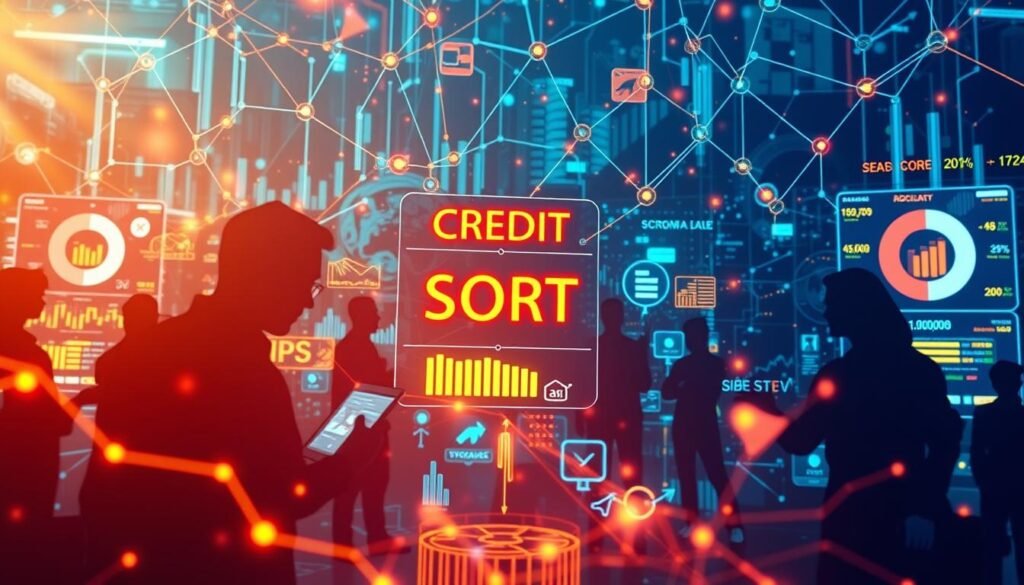Have you ever thought about how artificial intelligence could change how we check creditworthiness? The blend of AI and credit scoring models is a big deal in finance today. AI makes credit assessments more accurate by looking at lots of data we didn’t use before.
It helps by giving credit to people who were often left out. By using AI, we can get a better picture of how people handle money. This makes lending more fair for everyone.
If you’re curious about this new tech, there’s a lot to learn. Check out the basics of AI-based credit scoring here. For more on AI’s role in different areas, visit AiNosu.com.
Key Takeaways
- The impact of AI on enhancing credit scoring accuracy is profound.
- AI credit scoring models analyze a wider range of data compared to traditional methods.
- Dynamic evaluations through AI promote inclusivity in lending.
- Improving credit scoring with AI can benefit those historically overlooked.
- Understanding AI’s role in financial assessments is crucial for future developments.
Understanding AI Credit Scoring and Its Significance
Artificial intelligence credit scoring is changing how banks look at borrowers. It moves away from old methods that focus on just a few numbers. Now, advanced algorithms use lots of information to understand someone’s creditworthiness better.
With an ai credit approval system, lenders can look at more than just your credit score. They consider your spending habits, social actions, and other financial details. This gives a fuller view of how you handle money, making lending decisions more accurate.
AI credit scoring gets better over time because it learns from new data. This means it can help people with poor credit get loans easier. It also makes lending safer for banks. As more banks use these systems, protecting your personal data becomes very important. You should know how your data is handled, as explained in visitor data policies.
In short, moving to artificial intelligence credit scoring will change lending for the better. It will make getting credit fairer and risk assessments more reliable.
The Need for Smarter Credit Scoring Solutions
Today’s financial world needs smarter credit scoring solutions for more people, especially for the 1.5 billion ‘unbanked’ globally. Traditional models often leave out those with little or no credit history. This means many can’t get the financial services they need.
Using AI and credit scoring models, we can look at more types of data. This helps include people who were left out before. It makes getting credit more fair for everyone.
An advanced credit risk assessment helps lenders and borrowers both. AI lets banks quickly update their risk models. This keeps them up-to-date with the fast-changing market.

Using AI for credit scoring helps everyone, not just individuals. It also helps the economy by making financial services available to more people. Learn more about this change at advanced credit scoring solutions. Moving to new methods is key to meeting today’s financial needs.
How AI-Based Credit Scoring Works
AI-based credit scoring changes how we look at credit assessment. It uses complex steps to check if someone can handle credit well.
Data Collection and Analysis
First, it gathers lots of data. This includes things like bank records, online actions, and social media posts. This helps make a detailed picture of each person’s finances.
This way, it can better understand someone’s money habits and risks.
Machine Learning Models
Then, machine learning kicks in. AI looks at all the data to find patterns that show if someone is good with credit. This is key because it helps make a model that knows what makes someone financially reliable.
Predictive Analytics
Next, predictive analytics uses these patterns to help with new credit applications. It can guess how likely someone is to pay back a loan. This gives a fresh view on creditworthiness, unlike old methods.
Continuous Learning
Finally, the system keeps getting better over time. It learns from more data and feedback from loans. This makes the AI better at predicting creditworthiness, helping everyone involved.
| Phase | Process | Outcome |
|---|---|---|
| Data Collection | Diverse data sources gathering | Comprehensive applicant profiles |
| Machine Learning | Pattern recognition using algorithms | Predictive scoring models |
| Predictive Analytics | Application of patterns on new data | Informed credit decisions |
| Continuous Learning | Adaptation from feedback and new data | Improved scoring accuracy |
The Role of Artificial Intelligence in Credit Scoring
Artificial intelligence changes how we look at credit scores by using data to judge creditworthiness. AI algorithms can handle big data sets, finding patterns and connections that old methods miss.
This new tech boosts our ability to analyze data, helping us see more potential borrowers. I think AI can be key in giving credit to people who have been left out before, like those without a long financial history.
Using AI for credit ratings gives a deeper look into someone’s financial habits. It looks at more data, making credit scores more personal and fair. This leads to better lending decisions.
This tech change is big. It opens up credit to more people, especially those who were shut out before. This makes the financial world more inclusive.

For more details, check out the terms and conditions on using these new techs in credit systems.
How AI and Credit Scoring Models Differ from Traditional Models
I’ve looked into credit scoring and found big differences between old and new methods. Old credit scoring systems use past data and set rules. These methods often miss the complex ways people handle money. New credit scoring algorithms ai use advanced ways to look at more data types.
Machine learning credit scoring lets us check financial activities in real-time. This means scores can change with new information. Unlike old models, AI looks closely at each person’s financial life. This makes scores more personal and important for lenders.
Optimizing credit scoring models is another big plus of AI. It can quickly adjust to economic changes. This leads to more accurate scores and fewer defaults. AI’s power is a big hope for banks wanting to make their credit scoring better.
| Feature | Traditional Models | AI-Based Models |
|---|---|---|
| Data Dependence | Historical data only | Variety of data sources |
| Flexibility | Rigid rules | Dynamic scoring |
| Real-Time Assessment | Limited | Continuous evaluation |
| Customization | Generic scoring | Personalized insights |
| Response to Economic Changes | Slow adaptation | Quick adjustments |
Advantages of AI-Based Credit Scoring
Exploring AI in credit scoring shows it brings efficiency and improves lending. Enhancing credit scoring with ai lets financial institutions look at people in new ways. This leads to better decisions.
Inclusivity in Lending
AI-driven methods make lending more inclusive by using various data. This helps people without long credit histories get loans they might have missed out on before. It’s a big step forward for financial growth in underserved areas.
Improved Accuracy in Predictions
Algorithms in automated credit scoring are great at spotting hidden patterns. By using predictive modeling for creditworthiness, these systems make very accurate predictions about loan repayment.
Efficiency in Processing
Automated credit scoring systems are very efficient. They cut down processing time, letting lenders make quick decisions. This makes the customer experience better and helps financial institutions work better too.

| Advantage | Description |
|---|---|
| Inclusivity in Lending | Considers non-traditional data for wider access to loans. |
| Improved Accuracy | Utilizes advanced algorithms for precise creditworthiness predictions. |
| Processing Efficiency | Streamlines decision-making through rapid assessments. |
Overcoming Challenges in AI Credit Scoring
AI credit scoring systems have a big chance to make loan assessments more accurate. They face challenges like the black box problem and the need to be fair and unbiased. These issues must be solved for these models to work as promised.
Tackling the Black Box Problem
The black box problem means we can’t see how AI makes decisions. This lack of transparency can make people doubt the system. Tools like Shapley values can make the process clearer.
These tools show how different factors affect credit risk assessment with ai. With clear explanations, people can trust and hold AI systems accountable.
Addressing Bias and Fairness
Dealing with bias and fairness is a big challenge in AI credit scoring. Models that learn from biased data can keep making unfair loan decisions. To fix this, training data must show a wide range of people.
This makes the system fairer and more effective. It’s important to keep checking the data and how the models work. This helps make lending more fair for everyone.
AI-Driven Predictive Analytics in Credit Scoring
In recent years, the way we look at credit scoring has changed a lot. At the center of this change is predictive analytics in credit scoring. It uses past data to guess how likely someone is to pay back a loan. This helps lenders understand the risks of lending to different people.
Machine learning credit evaluation is amazing because it can look at lots of different data. It goes beyond just looking at credit history. This lets lenders find patterns that show if someone is likely to pay back a loan. This way, lenders can make better decisions and help more people get credit.

AI-driven predictive analytics is key in making lending smarter. It helps lenders manage risks better by looking at each borrower’s unique situation. This leads to more efficient lending and helps people who were once seen as too risky get credit.
These models keep learning and getting better over time. They adapt to new trends and how people behave financially. This means lenders can keep improving how they assess credit risks and adjust as the market changes.
Using predictive analytics in credit scoring and machine learning credit evaluation is a big step towards smarter lending. I’m excited to see how these changes will make getting credit fairer for everyone in the future.
Use Cases of AI in Credit Assessment
AI is changing how we look at credit assessment. It uses advanced tech to make processes better, leading to better financial results. Here are some key ways AI makes credit decisions smarter.
Loan Interest Rate Calculations
AI looks at borrowers’ risk levels with great accuracy. This lets lenders set interest rates that match each person’s situation. They consider things like credit history, income, and spending habits. This makes the interest rates fairer and more competitive.
Business Loan Approvals
Businesses need funding, but old ways often focus too much on past sales. AI looks at more things, like current data and how well a business runs. This means faster and more precise ai-driven credit decisions. It helps businesses with great potential get loans even if they don’t have a long history.
Fraud Detection and Risk Management
Using AI to spot fraud makes lenders better at catching suspicious actions. AI watches for unusual patterns in transactions and alerts them right away. This helps protect lenders and makes lending safer in our digital world.
Fintech Innovations in AI Credit Evaluation
The fintech sector is always moving forward, bringing new ideas to AI credit evaluation. These new technologies help make credit scoring more accurate and efficient. They use advanced tech to improve how credit is checked.
AI-driven algorithms are key in this change. They look at lots of data to better understand a borrower’s creditworthiness. Unlike old methods, AI can see the small details of how people handle money. It also changes with new trends.

Here are some key benefits of embracing innovative credit scoring technology:
- Increased Speed: Automation makes things faster, so loans get approved quicker.
- Enhanced Personalization: Algorithms look at many factors, making evaluations fit each person’s situation.
- Regulatory Compliance: These advanced models follow industry rules and are clear about it.
By using new credit scoring tech, fintech companies get ahead and make things better for users. They focus on the customer, building trust and promoting good financial health for everyone.
| Feature | Traditional Methods | Innovative AI Approaches |
|---|---|---|
| Data Usage | Limited data sources | Multiple diverse data sources |
| Processing Speed | Slow processing time | Rapid, near-instant approvals |
| Accuracy | Static scoring models | Dynamic learning algorithms |
| Scalability | Difficult to scale | Highly scalable systems |
Thanks to these changes, fintech credit evaluation is leading the way in how we look at credit risk in finance.
The Future of AI and Credit Scoring
The world of credit scoring is changing fast thanks to new technology. I’m looking into the future, and two big things stand out: foundation models and generative AI. These changes could make credit scoring more accurate and fair.
Foundation Models in Credit Scoring
Foundation models are key to building better credit scoring tools. They use huge amounts of data to make smart algorithms. This credit scoring innovation ai helps lenders make choices based on data, making predictions more accurate.
By using different kinds of data, foundation models get a fuller picture of someone’s creditworthiness.
Generative AI Applications
Generative AI is crucial for creating new data that can improve credit checks. It helps with ai-powered credit analysis by making realistic data scenarios. This leads to better risk assessments and more tailored financial products.
Being able to simulate different financial situations means more informed decisions. It could also make financial services available to more people.

How AI Can Enhance Financial Inclusivity
AI is key to making finance more inclusive. It helps break down barriers that have stopped many from getting credit. By using advanced algorithms, AI looks at more data, giving a fuller picture of creditworthiness. This is especially important for those who were often left out by old scoring methods.
AI changes how we assess credit risk, making lending more tailored to each person. It uses different data to understand borrowers better. This leads to fairer lending, helping more people get funding they couldn’t before.

Using machine learning to improve credit decisions opens up more access and makes lending more accurate. AI spots patterns in data that old methods miss. This helps financial institutions reach more people responsibly.
In conclusion, AI in finance brings big benefits. It makes finance more inclusive, helping individuals and boosting the economy.
Real-World Implementations of AI in Credit Scoring
Many financial institutions have started using AI in their credit scoring. They’ve seen big improvements in accuracy and efficiency. These examples show how AI can change the game in the industry.
Case Studies from Leading Financial Institutions
Let’s look at how AI is used in real situations:
- Institution A: Used machine learning to boost credit scoring accuracy by 30%. This made their risk assessment more accurate for each customer.
- Institution B: Cut down loan application processing time by 25% with AI. This made customers much happier.
- Institution C: An AI model cut default rates by 15%. It used real-time data for quick decisions.
These examples show how top financial institutions are using AI. They’re making their credit assessment better and changing the lending world.

The Importance of Data Quality in AI Credit Scoring Models
The success of AI in credit scoring depends a lot on the data used. Data quality in ai credit scoring is key. It means having clean, diverse, and representative data. Bad or missing data can lead to wrong credit scores.

- Improved Accuracy: High-quality data makes predictive models more accurate, leading to better credit decisions.
- Minimized Bias: Diverse datasets reduce bias in credit scoring, making lending fairer.
- Informed Decision-Making: Accurate data helps financial institutions make smarter choices, lowering lending risks.
To show why data quality matters, let’s look at key traits that affect AI financial models:
| Data Quality Factor | Description | Impact on AI Credit Scoring |
|---|---|---|
| Completeness | All required data fields must be filled. | Ensures a full picture of the applicant’s creditworthiness. |
| Accuracy | Data must represent the real-world situation. | Reduces chances of incorrect scoring and credit denial. |
| Consistency | Data should be uniform across datasets. | Enhances reliability of predictions. |
| Timeliness | Data must be current and updated regularly. | Reflects the latest financial behaviors of applicants. |
Improving data quality can greatly boost AI-driven credit evaluation. Strong datasets lead to fairer lending and better financial health for consumers.
Conclusion
Artificial intelligence credit scoring is changing the financial world in big ways. It uses advanced algorithms for a more precise and efficient way to check creditworthiness. This technology is making credit assessments better.
AI can look at more data than old methods, making lending more inclusive. People who were once left out now have a chance to get credit. This change helps make the financial world fairer for everyone.
As AI keeps getting better, we can expect even more changes in credit scoring. I suggest you check out this in-depth article to learn more about AI’s impact. Let’s see how these advancements will make finance more accessible for everyone.




